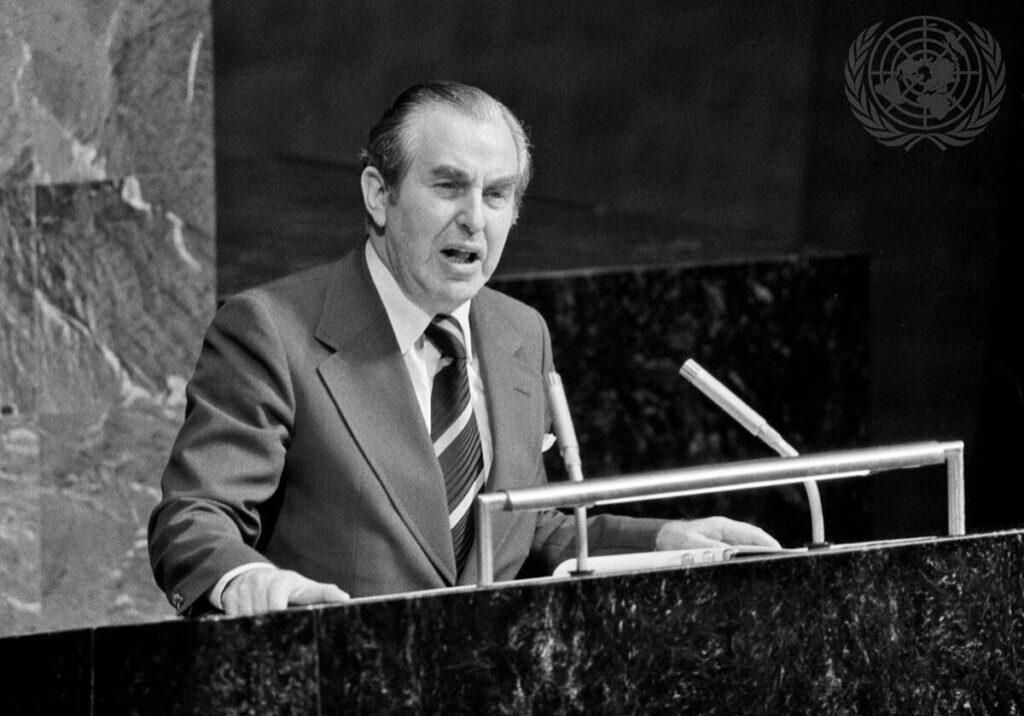Australia/Israel Review
The Biblio File: The Triumph and Tragedy of Ari Shavit
May 27, 2014 | Sol Stern

My Promised Land: The Triumph and Tragedy of Israel
Ari Shavit, Spiegel & Grau, 445 pages, US$28
Sol Stern
Ari Shavit’s My Promised Land may well be the most commercially successful, yet also critically acclaimed book by an Israeli writer explaining his country’s complicated history to English-speaking readers.
Some of this adulation is well deserved. Shavit is the most talented Israeli journalist of his generation. Like most of his Haaretz colleagues Shavit started out as an enthusiast for the Oslo accords and the peace process, but then experienced second thoughts. He broke with the Israeli left after becoming convinced by facts on the ground that the Palestinians were not reliable partners for achieving a compromise, two-state solution.
Shavit writes beautifully in Hebrew and English. Indeed, My Promised Land was composed in English and targeted at the American market. Before publication the author told friends that his book was positioned to appeal to hard line supporters of Israel as well as dovish groups, like J Street, more critical of Israeli government policies.
So far, Shavit’s hopes have been realised. Thus, the New Yorker published an edited excerpt from Shavit’s long chapter describing the Israeli army’s brutal expulsion of Palestinian Arabs from the city of Lydda during the 1948 Arab-Israeli war. “Lydda is the black box of Zionism,” Shavit writes in the New Yorker. “The truth is that Zionism could not bear the Arab city of Lydda.” At almost the same time, the Wall Street Journal published a different excerpt from the book under the title, “In Israel, a Dream Made Real.”
Some reviewers of My Promised Land have suggested that Shavit’s ability to balance two seemingly contradictory truths – the “remarkable success of Zionism” and the “black box of Zionism” – is precisely the quality that makes the book so compelling.
Measured by word volume alone, Shavit’s book tilts more towards the glorious side of Zionism’s ledger than to its supposedly darker side. There are four or five extremely moving chapters depicting the Zionist revolution’s “miraculous” accomplishments: reclaiming and cultivating the land, rescuing a people devastated by the shadows of the Holocaust, building a robust entrepreneurial economy and creating an artistic and cultural renaissance. And all of these “wonders” took place even while the people of Israel remained under constant military threat.
Shavit devotes only one full chapter to Zionism’s “black box” – an account of what was done to the Arabs of Lydda by Israeli military forces during three days in July, 1948. Yet it makes no sense to balance Shavit’s condemnation of Zionism’s foul deed at Lydda by citing the book’s depiction of the Zionist project’s many admirable accomplishments. The balancing act doesn’t work because Shavit’s Lydda chapter is based on such a gross historical distortion that it overwhelms his testimonial to the positive, miraculous side of Zionism.
There is little new in Shavit’s factual description of the events in Lydda from July 11 to July 13, 1948. All serious historians of the period have acknowledged what happened in the Palestinian Arab city during those three violent days. What Shavit does is to take an old story out of context and give it a moral weight it can’t bear.
Immediately after David Ben Gurion declared Israel’s independence on May 14, 1948, the new state was invaded by five Arab armies. The most effective of these military forces was the Jordanian Arab Legion, commanded by British officers. The Legion laid siege to Jerusalem and eventually forced all Jews living in the Old City out at bayonet point. The Jordanians also came close to cutting the road from Tel Aviv to Jerusalem, thus endangering the heartland of the Jewish State. Lydda, (with a population of over 40,000 Arabs) was just 11 miles east of Tel Aviv on the route to Jerusalem. In early July, IDF commanders determined that they must remove the Legion’s threat to Israel’s largest city and try to secure the road to Jerusalem. Military necessity dictated that Lydda and several adjoining villages must be conquered.
As Shavit describes the action, an IDF armoured column sped through Lydda on the morning of July 11, firing at everything in its way. After a 47 minute battle more than a hundred Arab civilians and nine Israeli soldiers were dead. However, on the next day Jordanian armoured cars suddenly returned to the city. Israeli soldiers were fired on again, including by armed Palestinian irregulars. Some of the Israeli forces then began shooting in all directions and throwing hand grenades into homes where they believed the shooting was coming from. The second wave of violence resulted in the deaths of another 200 Lydda residents.
News of the renewed fighting reached IDF headquarters, where the senior commander, Yigal Allon, asked Ben-Gurion what should be done with the Arabs of Lydda. According to Shavit, “Ben-Gurion waves his hand: Deport them.” Operations officer Yitzhak Rabin then issued the order: “The inhabitants of Lydda must be expelled quickly, without regard to age.” The next day, July 13, 1948, 35,000 Palestinian Arabs are on the road out of Lydda, walking east toward the Jordanian lines with little more than the clothes on their backs.
Shavit’s bare factual account of the fighting in Lydda is consistent with several histories of the first Arab-Israeli war, including Benny Morris’s volume, 1948, widely regarded as the definitive history of the conflict. But in his broader, historical interpretation of the events in Lydda and his sweeping moral judgment, Shavit goes far beyond the account by Morris.
“Lydda is our black box,” Shavit writes. “In it lies the dark secret of Zionism. The truth is that Zionism could not bear Lydda… If Zionism was to be, Lydda could not be. If Lydda was to be, Zionism could not be. In retrospect it’s all too clear. When Herbert Bentwich [a 19th century British Zionist leader, who happens to have been Shavit’s great grandfather] saw Lydda from the white tower of Ramleh in April, 1897, he should have seen that if a Jewish state was to exist in Palestine, an Arab Lydda could not exist at its center.”
It’s mindboggling that a book that won a prestigious award for Jewish history can include so many historical untruths in one short paragraph. If it’s the case, as Shavit claims, that “Zionism could not bear Lydda,” one would like to ask the author to explain how Zionism managed to bear the Arab city of Nazereth, where there were no expulsions (the city’s population is now 60,000) or how Zionism bears the Arab city of Umm al-Fahm (population 50,000) in the densely Arab populated area called “the triangle” in the centre of Israel.
Shavit claims that the early Zionists were blind to the existence of another people living on the land they coveted for their own state. Thus he argues, somewhat preposterously, that his own great-grandfather should have known in 1897 that a future Jewish state would mean the end of Arab Lydda. Shavit’s judgment about moral responsibility for Lydda may suit his narrative of Zionism’s original sin, but it runs counter to the historical record. There is overwhelming evidence (including even in Shavit’s own chapter) that the expulsion order at Lydda was ad hoc and contingent, rather than historically preordained. The decision was made because of the facts on the ground in a war launched by the Arab states and by Palestinian militias with the express intention of annihilating the Jews of Palestine.
At the beginning of the war, the Secretary General of the Arab League, Abdul Rahman Azzam, vowed: “This war will be a war of extermination and a momentous massacre which will be spoken of like the Mongol massacres and the crusades.” The leader of the Palestinian armed militias during the 1948 war was the ex- Mufti of Jerusalem, Haj Amin al-Husseini. Al-Husseini actively collaborated with Hitler in the implementation of the Final Solution. He made it clear that the objective of the 1948 war would be the annihilation of the Jews of Palestine. Shavit mentions none of this essential historical context when condemning Zionism for the expulsion of the residents of Lydda.
Nor does Shavit take into account any of several well documented counterexamples to the expulsion of the Lydda Arabs. In the mixed city of Haifa, for example, the Jewish mayor Shabtai Levy met with Arab leaders just before the war broke out. He was in tears as he begged them to tell their own people to stay in their homes and promised that no harm would befall them. The Arab leaders told Levy that they had been ordered out – and even threatened – by al-Husseini and must obey.
You might also say that it is Shavit who is blind to the reality of Palestinian history and to their own unacknowledged “black box” – the violent rejection, fuelled by Islamist beliefs, of any Jewish presence on the land. Shavit says almost nothing about the many Arab massacres of Jews, the expulsions of Jews from the cities of Hebron and Jerusalem, and the fact that not a single Jew was allowed to remain in any area occupied by the Arab armies during the 1948 war.
Another troubling aspect of Shavit’s Lydda chapter is its lack of scholarly citation. Shavit says that the material for the Lydda chapter came from “numerous accounts of the traumatic events recounted to me in the early 1990s by [a number of veterans of the fighting.]” Perhaps Shavit or his New Yorker editor realised that relying on 20-year-old oral interviews for his interpretation of Lydda would invite some serious evidentiary questions. So for the New Yorker article Shavit added that he had also used Benny Morris’s 2008 book, 1948: A History of the First Arab-Israeli War.
Rather than provide credibility for the Lydda chapter, however, this late citation of Morris raises even more questions about the validity of Shavit’s historical interpretation.
In 1948 and several other books Benny Morris rejected the thesis that the Zionists were either blind to the presence of the Arabs on the land, or that the Arab refugee problem was preordained. Morris does not regard the expulsion of the Lydda Arabs as a metaphor for the Zionist movement’s treatment of the Palestinian Arabs. Contrary to Shavit and other leftist, revisionist historians, Morris asserts in 1948 that the Palestinian calamity was “born of war, not by design.” One more item that is in Morris’ book, but goes unmentioned by Shavit, is that after the expulsion order some Arabs managed to remain in Lydda and today Lydda has a substantial minority of Arab citizens.
For the New Yorker‘s version of Shavit’s Lydda chapter, a new lead paragraph was added that attempts to provide contemporary relevance to Shavit’s account. Noting recent efforts by the Obama Administration to advance negotiations and “achieve peace between Israel and the Palestinians,” the paragraph asks whether this effort might succeed where others have failed. “It’s possible that the answer can be found in the history of Lydda,” Shavit writes. “Anyone striving for Middle East peace must acknowledge the tragedy of Lydda and comprehend its implications.”
In reality, Shavit’s interpretation of the Lydda expulsions and the attention his book is receiving is likely to make it harder – not easier – to achieve peace. The metaphor of Zionism’s “black box” plays directly into the false Palestinian narrative of the Naqba, which is now the single most important obstacle to achieving a realistic, compromise peace.
The Arabic word Naqba connotes a historical catastrophe inflicted on an innocent and blameless people, in this case the Palestinians, by an overpowering outside force (international Zionism). Thus on May 16, 2011, the New York Times published an op-ed by Mahmoud Abbas in which he declared that “shortly after” the U.N. General Assembly voted to partition the “Palestinian homeland, Zionist forces expelled Palestinian Arabs to ensure a decisive Jewish majority in the future state of Israel, and Arab armies intervened. War and further expulsions ensued.”
The Naqba is the heart of the Palestinians’ backward-looking national narrative. Every year, the legend grows of the evil deeds committed by the Zionists in 1948, crimes routinely equated with the Holocaust.
The only just compensation for the Naqba, say the Palestinians and their allies, is to give the refugees of Lydda and other Palestinian cities the “right of return” to their former homes in Israel.
Palestinian leaders know that there can be no serious negotiations for peace unless they explicitly renounce the right of return, which is really another way of calling for the elimination of Israel as a Jewish state. Shavit too understands this, and must know that his interpretation of the 1948 expulsion from Lydda will be used as an argument for the Palestinian right of return.
In the concluding paragraph of the Lydda chapter, Shavit writes that he recently went up to the highest point in the area and looked down on Lydda as it is today. He imagines that he sees the awful column of Lydda’s refugees still marching: “So many years have passed, and yet the column is still marching east. For columns like the column of Lydda never stop marching.”
Contrary to many of Shavit’s reviewers, there is nothing courageous about this kind of writing that is plainly wrong on the facts and relies on a false historical interpretation to enforce its moral logic. The refugees of Lydda may still be marching in Shavit’s vivid but distorted imagination, but in reality they and their descendants – now totalling 5-7 million souls – have been locked up for the past 65 years in miserable refugee camps. It is not because of Zionism that they are still there. Rather it’s their own leaders and the Arab regimes who want them to remain locked up.
This is a worse crime than the Lydda expulsions. And yet there is a certain perverse logic to this policy, since it allows Palestinian leaders to continue feeding the refugees a daily diet of Jew hatred, along with the illusion that someday they will be returning in triumph to their homes in Lydda and other Israeli cities.
Unfortunately, Ari Shavit’s “black box” of Lydda does not contain any of these hard truths. And that is the so far unacknowledged “tragedy” of Shavit’s book.
Sol Stern is a senior fellow at the Manhattan Institute and a contributing editor of City Journal. © Daily Beast, reprinted by permission, all rights reserved.
Tags: Israel






